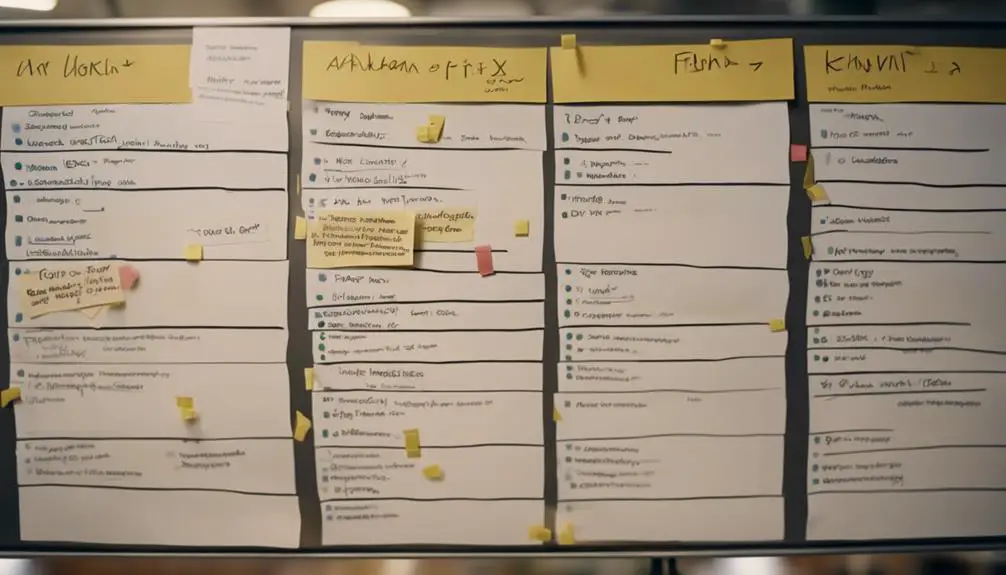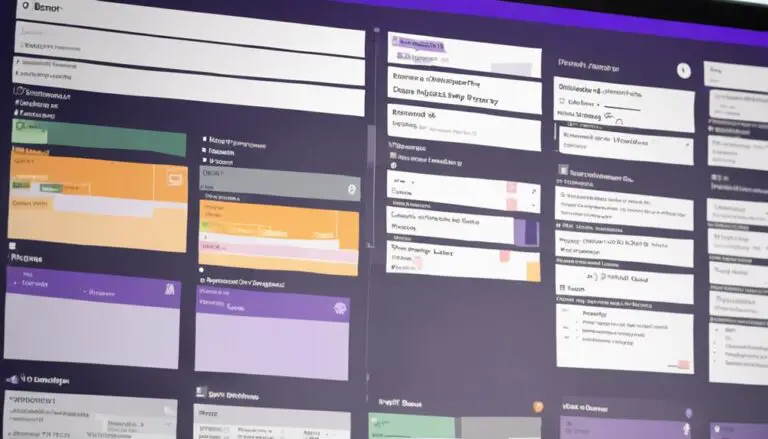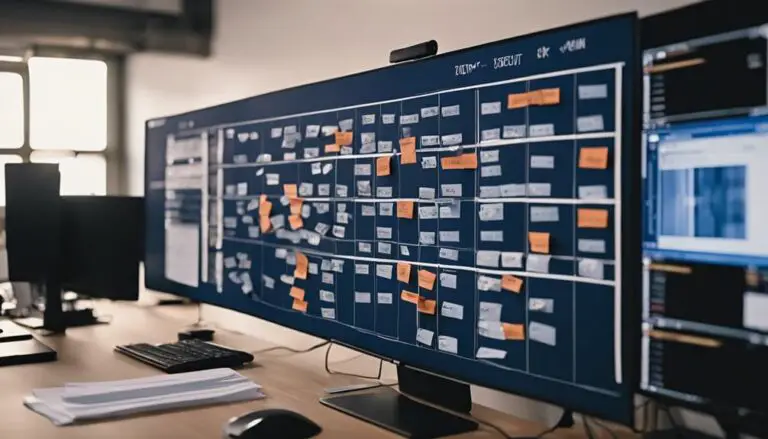You may have pondered how Kanban seamlessly integrates within the Agile framework, offering a structured yet flexible approach. As you explore this dynamic relationship, you'll uncover how Kanban's principles align with Agile's core values, enhancing project management practices. Kanban’s emphasis on visualizing work and limiting work in progress complements Agile’s focus on delivering value to customers through continuous delivery. Additionally, kanban implementation in safe enables organizations to scale Agile practices across multiple teams, providing a framework for coordination and alignment. Overall, the integration of Kanban within Agile offers a powerful set of tools and principles for managing projects in a dynamic and responsive manner.
The synergy between the two methodologies opens avenues for improved efficiency and collaboration, making it a compelling topic for project managers and teams alike. Stay tuned to unravel the intricate connections between Kanban and Agile, and discover the invaluable insights they hold for optimizing workflows and achieving project success.
Key Takeaways
- Kanban enhances Agile by visualizing workflow and limiting work in progress for optimized efficiency.
- Integrating Kanban with Agile practices fosters a culture of adaptability and continuous improvement.
- Kanban in Agile ensures transparency, collaboration, and effective task management for streamlined processes.
- Combining Kanban with Agile principles creates a potent mix for efficient project management.
Understanding Kanban's Role in Agile
Understanding how Kanban fits into the Agile framework requires recognizing its key role in promoting continuous improvement and workflow enhancement. Kanban, as an Agile methodology, focuses on visualizing work, limiting work in progress, and enhancing team efficiency to drive incremental changes.
By embracing these principles, Kanban facilitates team empowerment and fosters a culture of continuous improvement within the Agile environment. The practice of visualizing work on Kanban boards allows teams to have a clear overview of tasks, promoting transparency and collaboration.
Limiting work in progress ensures that teams concentrate on completing tasks before taking on new ones, thus optimizing workflow and team efficiency. This approach not only enhances team productivity but also aligns with Agile values of customer involvement and responsiveness.
Kanban's emphasis on incremental changes and continuous delivery resonates well with the iterative development approach of Agile methodologies, making it a valuable tool for achieving customer satisfaction and adapting to changing requirements.
Key Principles of Kanban in Agile
To effectively integrate Kanban into the Agile framework, focus on the key principles that emphasize visualizing workflow stages and limiting work in progress for continuous improvement. By clearly visualizing workflow stages, teams can identify bottlenecks and optimize their processes for efficient delivery. Limiting work in progress ensures that teams focus on completing tasks before taking on new ones, ultimately leading to better quality outcomes.
Kanban's core principles also include managing flow, implementing feedback loops, and promoting adaptive planning, which all contribute to a culture of continuous improvement within Agile projects.
Furthermore, Kanban's emphasis on incremental changes aligns well with Agile values, allowing for flexibility and customer satisfaction. By making policies explicit and evolving collaboratively, teams can adapt to changing requirements and deliver value consistently. Transparency is key in Kanban, fostering a culture of openness and collaboration that supports the Agile manifesto's principles.
Embracing these core principles of Kanban in Agile practices can lead to more effective project management and improved team performance.
Integrating Kanban With Agile Practices
Let's explore how incorporating Kanban in Scrum can enhance continuous improvement techniques within Agile practices.
By integrating Kanban with Agile, teams can foster a culture of visualizing work and optimizing flow to boost project outcomes.
This collaboration between Kanban and Agile methodologies can lead to improved efficiency and streamlined processes in project management.
Kanban in Scrum
Integrating Kanban boards into Scrum teams enhances workflow visualization and task management flexibility within Agile practices. By combining Kanban's focus on continuous flow with Scrum's sprint-based structure, teams can optimize efficiency without deviating from the core Scrum framework. This integration allows for improved transparency, better prioritization, and smoother task management.
The synergy between Kanban and Scrum creates a potent mix, providing a versatile and effective approach to Agile project management. Teams benefit from enhanced collaboration, adaptability, and iterative progress tracking. Embracing Kanban within Scrum fosters a sense of belonging and shared purpose among team members, ensuring alignment towards common goals and successful project outcomes.
Continuous Improvement Techniques
Embrace the power of continuous improvement techniques by seamlessly integrating Kanban within Agile practices to enhance collaboration and flexibility in project management.
Kanban's focus on visualizing workflow and limiting work in progress aligns perfectly with the Agile framework's principles of responding to change and customer satisfaction.
By integrating Kanban with Agile practices, teams can optimize workflow, promote team collaboration, and achieve iterative development.
This integration ensures tasks flow smoothly, leading to higher productivity, better transparency, and quicker responses to evolving project requirements.
Embracing continuous improvement through the fusion of Kanban and Agile methodologies not only enhances project management but also fosters a culture of adaptability and continuous growth within the team.
Benefits of Using Kanban in Agile
You'll appreciate how Kanban in Agile brings clarity to your workflow by visualizing tasks, aiding in better prioritization.
It helps you manage work in progress effectively, ensuring tasks are completed before taking on new ones.
With a continuous improvement focus, Kanban fosters a culture of adaptability and efficiency within your Agile team.
Workflow Visualization Advantages
By leveraging Kanban's visual representation of work items on a Kanban board, Agile teams gain valuable transparency and clarity in managing their workflow. The Kanban board allows for easy visualization of work item flow, helping teams pinpoint bottlenecks and enhance efficiency.
This visual representation fosters collaboration and effective communication within the team by providing a clear overview of work progress. Agile teams find it easier to identify work priorities, optimize processes, and maintain a steady work pace through Kanban's workflow visualization advantages.
Moreover, the use of Kanban in Agile methodology promotes continuous improvement, enabling teams to adapt swiftly to changing priorities and focus on delivering incremental value. Embrace these visualization benefits to streamline your workflow and drive successful Agile practices.
Limiting Work in Progress
To enhance team efficiency and productivity in Agile processes, implementing work in progress limits within Kanban is a strategic approach that fosters smoother workflows and improved collaboration. By setting limits on work in progress, Kanban helps teams focus on completing tasks before taking on new ones, reducing multitasking and increasing overall efficiency.
This reduction in multitasking leads to higher productivity and better quality work. Additionally, work in progress limits promote a more predictable workflow, minimize bottlenecks, and ensure that teams can deliver value more consistently.
Embracing work in progress limits in Kanban under the Agile framework encourages continuous improvement and facilitates faster delivery of work items, ultimately benefiting the team's performance and goal achievement.
Continuous Improvement Focus
Enhancing team efficiency and productivity within the Agile framework, Kanban's continuous improvement focus through visualizing workflow and limiting work in progress drives iterative enhancements and fosters a culture of adaptability and learning.
By utilizing Kanban in Agile, teams can identify bottlenecks, enhance efficiency, and quickly adapt to changing requirements. The emphasis on incremental changes and evolutionary enhancements in Kanban aligns with Agile's principles of delivering value iteratively and responding to customer feedback.
This continuous improvement aspect not only supports Agile's goal of adapting to changing business needs but also cultivates a culture of learning, experimentation, and adaptability. Through Kanban, teams can drive ongoing success in project delivery by continuously evolving and improving their processes.
Implementing Kanban Within Agile Teams
When implementing Kanban within Agile teams, visualizing work, limiting work in progress, and focusing on continuous flow are key practices to enhance collaboration and efficiency.
Kanban, a visual workflow management tool, seamlessly integrates into the Agile framework, emphasizing flexibility, adaptability, and collaboration. By visualizing work through Kanban boards, teams gain transparency, enabling better coordination and understanding of project status.
Limiting work in progress prevents overloading team members, promoting a steady workflow and timely task completion. Focusing on continuous flow ensures tasks move smoothly from start to finish, reducing bottlenecks and enhancing productivity. This approach fosters incremental improvements, aligning with Agile principles of iterative development and customer feedback.
Embracing Kanban within Agile methodologies empowers teams to adapt quickly to changing priorities, optimize workflows, and deliver value efficiently. By embracing these practices, Agile teams utilizing Kanban create a dynamic environment that thrives on collaboration, transparency, and continuous enhancement.
Enhancing Agile Workflows With Kanban
By incorporating Kanban into your Agile workflows, you can elevate transparency and efficiency within your team's processes. Kanban, as a visual management tool, enhances workflow transparency by visualizing work and limiting work in progress. This approach promotes collaboration and continuous improvement, aligning with Agile principles.
By focusing on flow optimization and incremental changes, Kanban supports iterative development and customer-centric delivery. The emphasis on feedback loops ensures teams can adapt quickly and deliver value effectively in Agile environments. Kanban's flexibility and quality-oriented approach make it a valuable addition to Agile methodologies, enabling teams to respond to change efficiently.
Frequently Asked Questions
What Are the 4 Elements in Kanban Under Agile Methodology?
You visualize workflow, limit work, manage flow, and optimize processes in Kanban under Agile. Visualize tasks, set limits, improve continuously, and enhance collaboration. Prioritize tasks, reduce waste, increase efficiency, monitor progress—Kanban fosters a culture of productivity and teamwork in Agile.
What Is the Relationship Between Agile Scrum and Kanban?
In understanding the relationship between Agile Scrum and Kanban, recognize their differences in time-boxing and continuous flow. Scrum has fixed sprints, while Kanban flows without set timeframes. Both methods align with Agile principles for iterative improvement.
Is Kanban Part of Lean or Agile?
Lean principles emphasize efficiency, while Agile practices focus on collaboration. Kanban, part of Lean's visual management, aligns with Agile's customer focus and continuous improvement. By limiting work and optimizing workflows, Kanban enhances process efficiency and incremental delivery.
What Are the Three Basic Rules of Agile Kanban?
To excel in Agile Kanban, grasp its core: visualize workflow, limit work, boost flow. These principles foster team unity, amplify efficiency, and refine processes. Embrace them for seamless collaboration and continual enhancement.
Conclusion
In conclusion, Kanban seamlessly integrates within the Agile framework, enhancing team collaboration and continuous improvement. By visualizing workflow and limiting work in progress, Kanban optimizes project management efficiency.
Remember, just like a well-oiled machine, combining Kanban with Agile practices ensures smooth operations and timely deliveries. So, keep embracing change, adapting to challenges, and iterating on your processes to achieve success in your projects.
Let the flow of Kanban guide you towards agile excellence!





